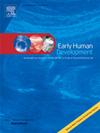荷兰极度早产新生儿的初级呼吸支持:一项全国性调查。
IF 2
3区 医学
Q2 OBSTETRICS & GYNECOLOGY
引用次数: 0
摘要
无创呼吸支持策略已经发展到避免早产儿支气管肺发育不良(BPD)。然而,关于最佳治疗策略的共识仍然缺乏。本研究旨在调查荷兰新生儿重症监护病房(NICUs)中极早产儿初级呼吸支持的现状和变化。方法:向荷兰的新生儿科医生发放一份基于网络的问卷。调查涵盖了呼吸支持方式的选择、应用标准和相关的临床实践等方面。结果:有效率为48.5%(66/136)。大多数患者使用持续气道正压通气(CPAP)作为主要呼吸支持;胎龄≤26周的占73.8%,胎龄26 ~ 28周的占88.9%。最常用的替代方法是无创正压通气(NIPPV)。特别是在NIPPV环境中发现了显著的差异。在CPAP和NIPPV中,每个NICU在无创表面活性剂给药(LISA)期间的呼吸支持有所不同,但总体CPAP是首选。GA≤26周(30.2%)和GA在26 ~ 28周(22.2%)的婴儿在产房给予咖啡因。81%的婴儿在出生后的第一周避免使用多普唑仑,与GA无关。结论:该研究强调了荷兰初级新生儿呼吸支持的不同实践,NIPPV设置存在显著差异,而CPAP使用具有统一性,强调需要有凝聚力的指南和培训来标准化护理和改善极度早产儿的结果。本文章由计算机程序翻译,如有差异,请以英文原文为准。
Primary respiratory support of extremely preterm neonates in the Netherlands: a national survey
Introduction
Non-invasive respiratory support strategies have evolved to avoid bronchopulmonary dysplasia (BPD) in preterm infants. However, consensus on the best treatment strategy remains lacking. This study aims to investigate current practices and variations in primary respiratory support for extremely preterm neonates across neonatal intensive care units (NICUs) in the Netherlands.
Methods
A web-based questionnaire was distributed to neonatologists in the Netherlands. The survey covered aspects like the choice of respiratory support modalities, criteria for their application, and associated clinical practices.
Results
The response rate was 48.5 % (66/136). The majority used continuous positive airway pressure (CPAP) as primary respiratory support; 73.8 % for infants with gestational age (GA) ≤26 wks and 88.9 % for infants with GA 26–28 wks. The most used alternative was non-invasive positive pressure ventilation (NIPPV). Significant variation was particularly found in NIPPV settings. Respiratory support during less invasive surfactant administration (LISA) varied per NICU between CPAP and NIPPV, but overall CPAP was preferred.
Caffeine was administered in the delivery room into infants with GA ≤26 weeks (30.2 %) and GA between 26 and 28 weeks (22.2 %). Doxapram was avoided in the first week of life in 81 % of the infants, independent of their GA.
Conclusion
The study highlights diverse practices in primary neonatal respiratory support in the Netherlands, with significant variation in NIPPV settings while there is uniformity in CPAP use, underscoring the need for cohesive guidelines and training to standardize care and improve outcomes for extremely preterm neonates.
求助全文
通过发布文献求助,成功后即可免费获取论文全文。
去求助
来源期刊

Early human development
医学-妇产科学
CiteScore
4.40
自引率
4.00%
发文量
100
审稿时长
46 days
期刊介绍:
Established as an authoritative, highly cited voice on early human development, Early Human Development provides a unique opportunity for researchers and clinicians to bridge the communication gap between disciplines. Creating a forum for the productive exchange of ideas concerning early human growth and development, the journal publishes original research and clinical papers with particular emphasis on the continuum between fetal life and the perinatal period; aspects of postnatal growth influenced by early events; and the safeguarding of the quality of human survival.
The first comprehensive and interdisciplinary journal in this area of growing importance, Early Human Development offers pertinent contributions to the following subject areas:
Fetology; perinatology; pediatrics; growth and development; obstetrics; reproduction and fertility; epidemiology; behavioural sciences; nutrition and metabolism; teratology; neurology; brain biology; developmental psychology and screening.
 求助内容:
求助内容: 应助结果提醒方式:
应助结果提醒方式:


